Episode 136: STS-59 - Vaya con Dios (SRL-1)
Table of Contents
We’ve got a giant radar in the payload bay, bubbles in the water, and we’re ready to learn about somebody’s favorite type of lizard. We’ve also got a whole bunch of cameras, and what sure looks like over 150 VHS tapes. It’s time for STS-59!
Episode Audio #
Photos #
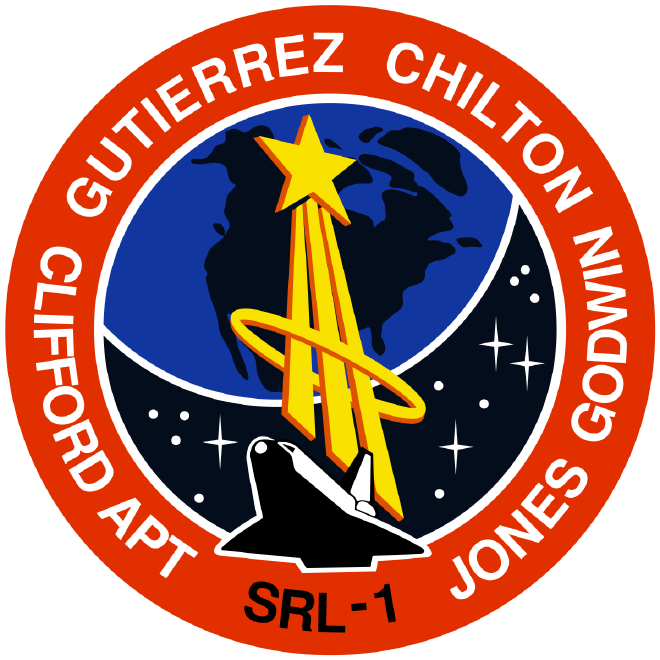
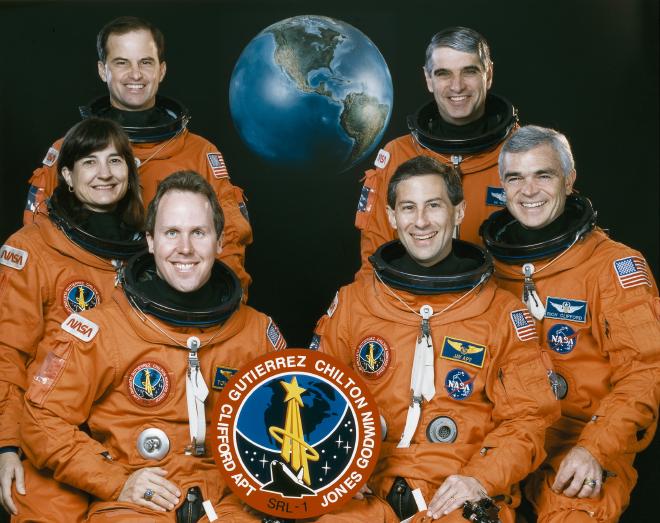
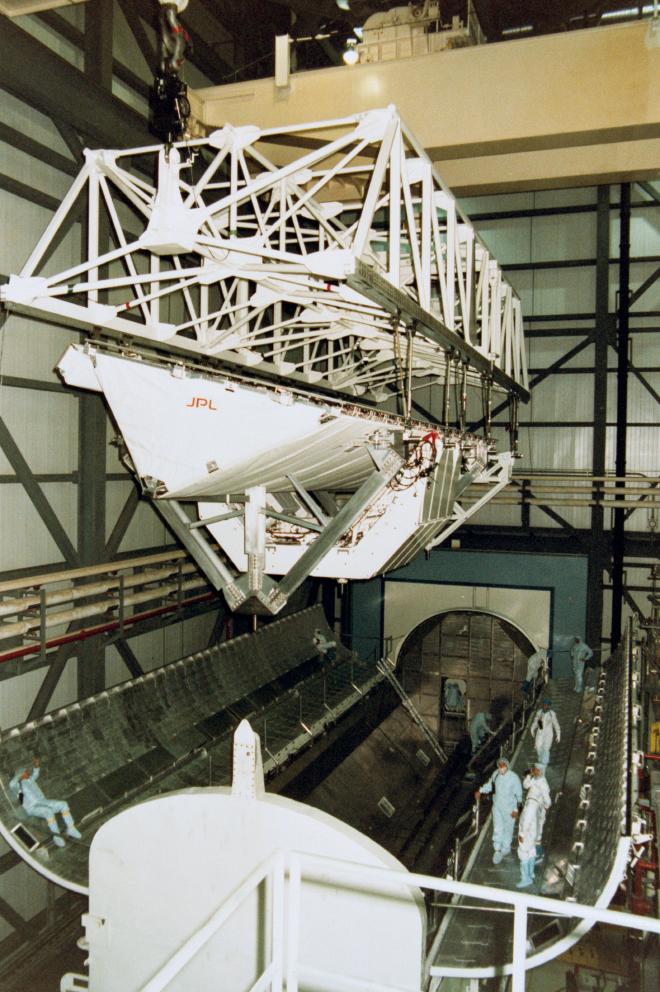
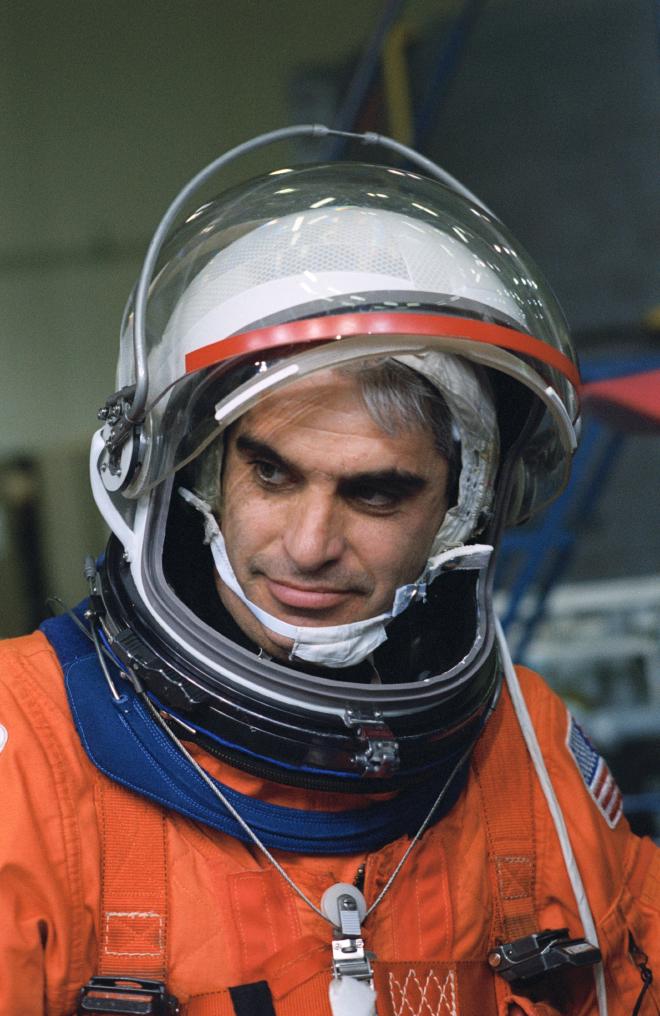
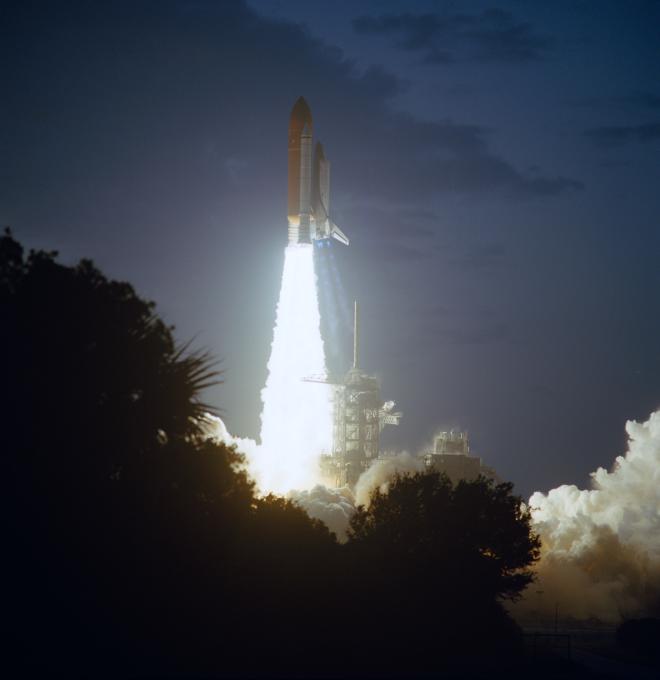
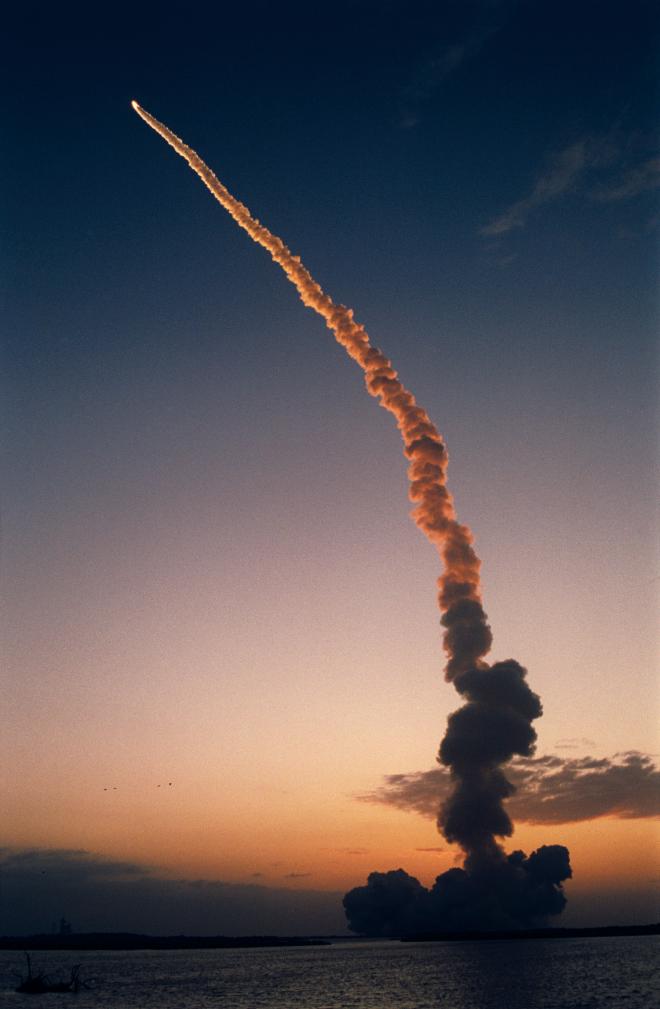
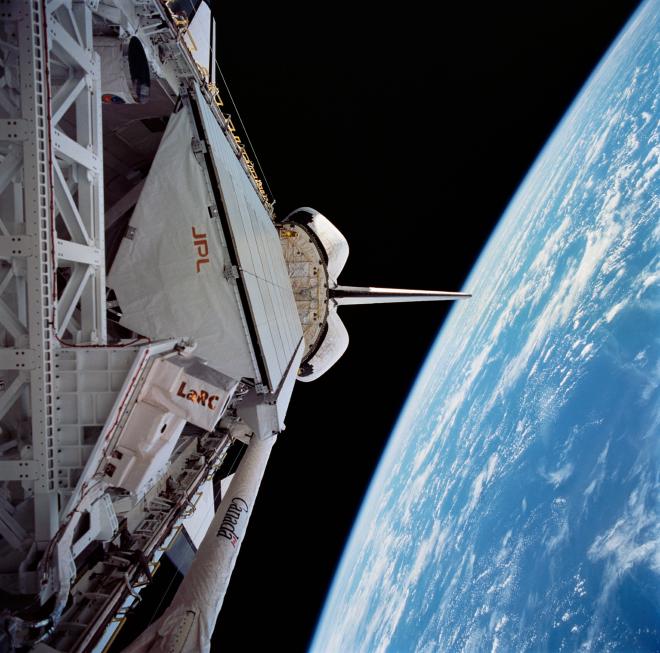
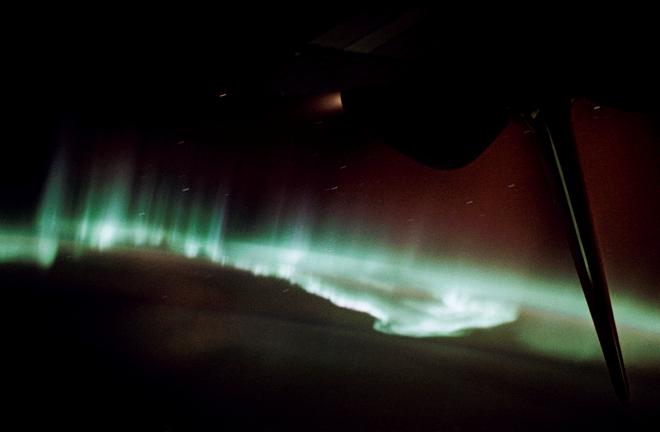
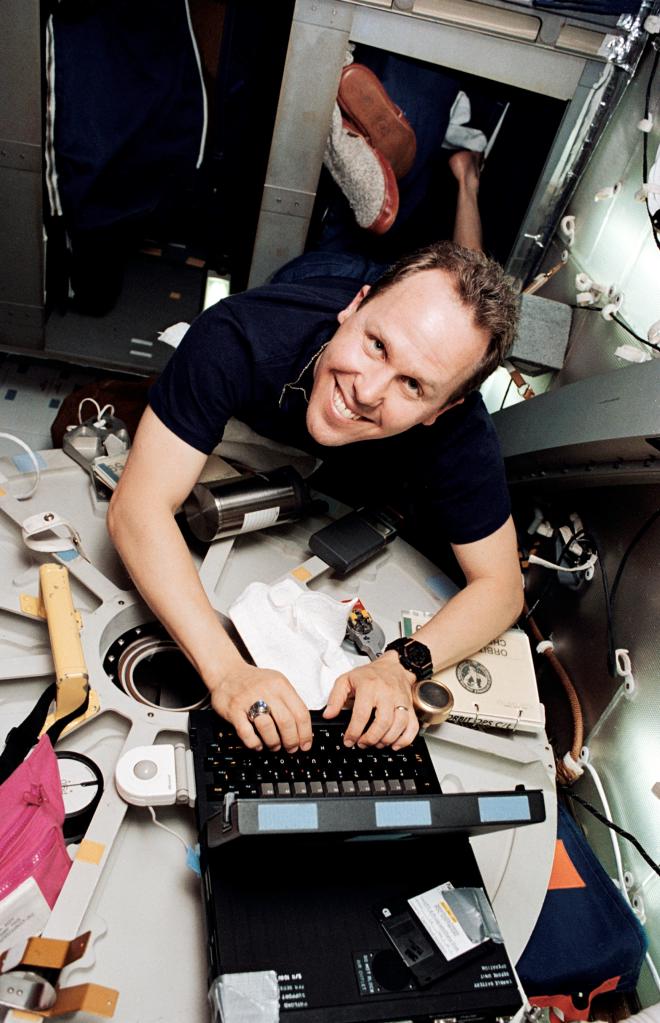
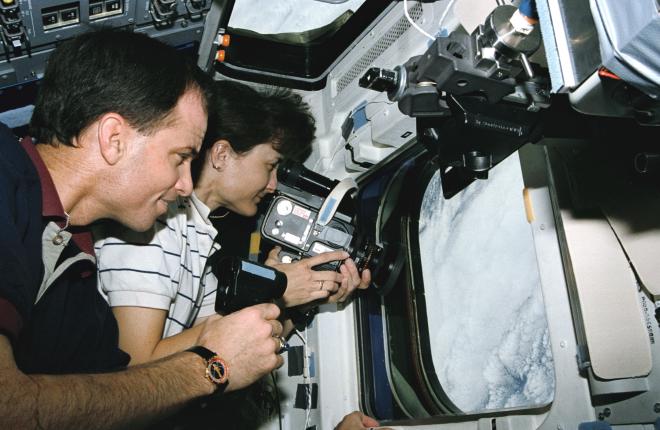
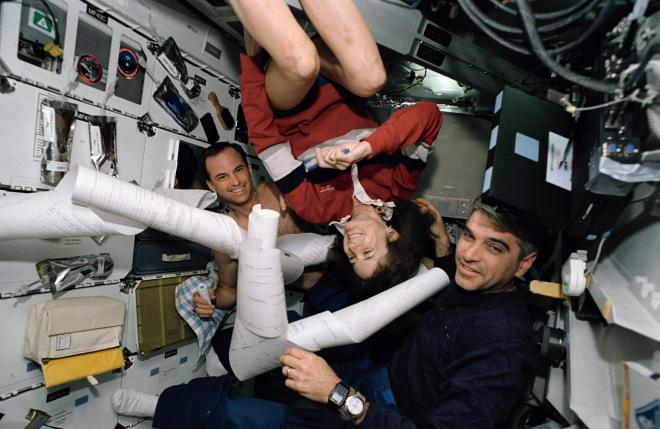
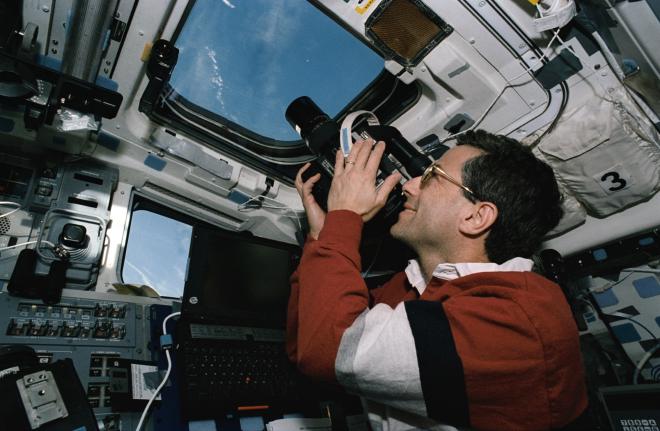
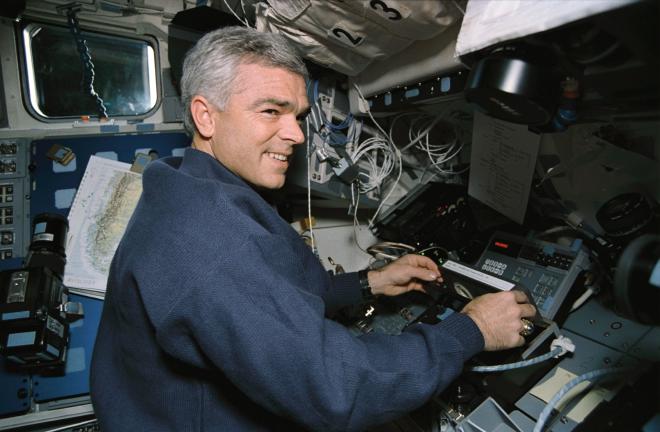
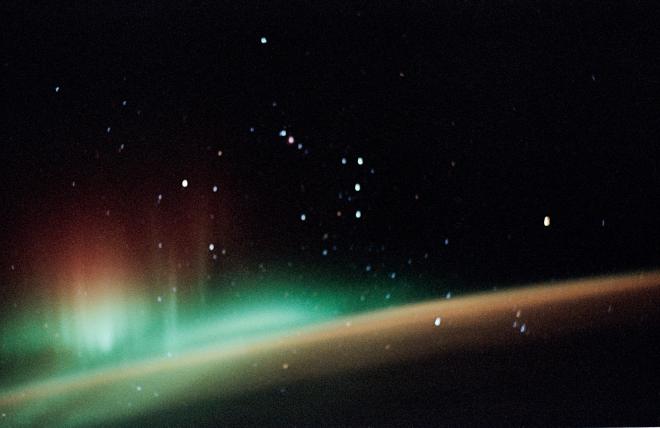
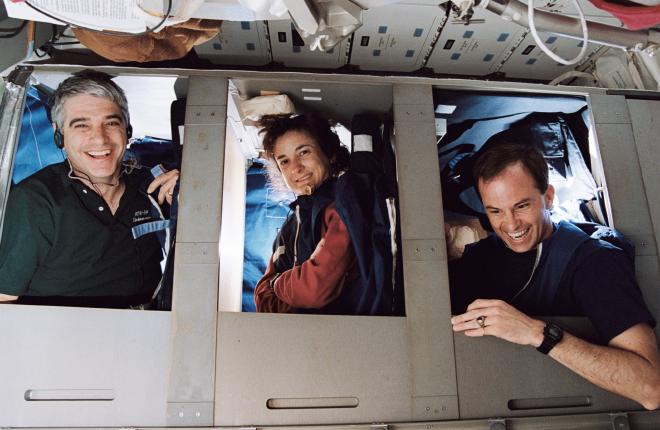
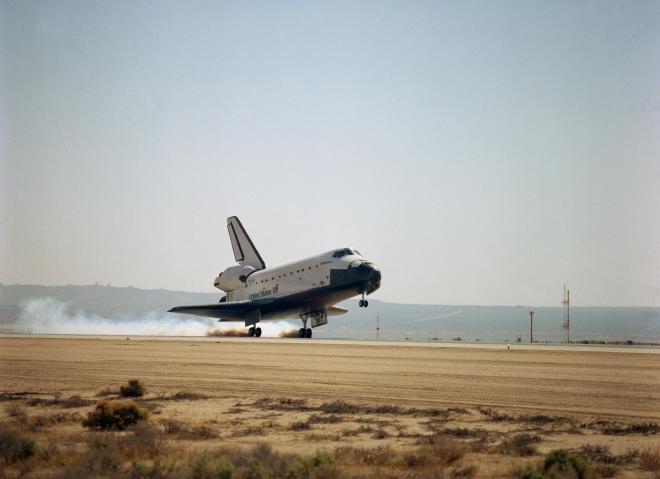
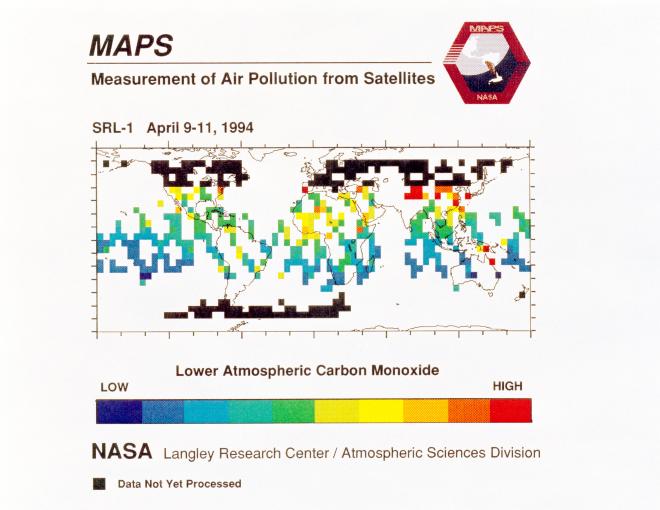
Post-Flight Presentation #
If you’d like to see the mission in motion you can check out the post-flight presentation here:
Tom Jones’s Book #
Definitely take a look at STS-59 crewmember Tom Jones’s excellent book Sky Walking: An Astronaut’s Memoir
Transcript #
NOTE: This transcript was made by me just copying and pasting the script that I read to make the podcast. I often tweak the phrasing on the fly and then forget to update the script, so this is not guaranteed to align perfectly with the episode audio, but it should be pretty close. Also, since these are really only intended to be read by myself, I might use some funky punctuation to help remind myself how I want a sentence to flow, so don’t look to these as a grammar reference. If you notice any egregious transcription errors or notes to myself that I neglected to remove, feel free to let me know and I’ll fix it.
Hello, and welcome to The Space Above Us. Episode 136, Space Shuttle Flight 62, STS-59: Vaya con Dios
Last time, we got two missions for the price of one with STS-62. We flew a bunch of ground-operated material science experiments and also checked out a set of new space technology engineering tests. We learned a lot about the properties of xenon around its critical point, the tight tolerances supported by the Dexterous End Effector, and we wondered if the ground support staff thought that the crew smelled like garbage. For today’s flight, we’ll be focusing on a small number of instruments, but we’ll use them to examine the Earth more deeply than ever before.. literally. That’s because on STS-59, Space Shuttle Endeavour will be carrying the most advanced synthetic aperture radar spacecraft NASA had flown to date.
It’s been a while since we last talked about synthetic aperture radar, so let’s do a quick refresher. Most scientific satellites are equipped with sensors that passively detect radiation. That is, they’re just looking for different wavelengths of light that are already out in the universe. If you’re looking at the Earth, you’re looking at sunlight reflecting off the surface, which then gets collected by your sensor, allowing you to learn about what’s going on down there. If you’re looking at x-rays from distant galaxies, it’s the same deal. You build a sensor that can detect x-rays, point it at some galaxies, and wait to collect enough photons to study whatever it is you want to study.
Radar is a little different. Rather than wait for the photons of interest to come to you, you’re going to send them out in the world. You can sort of think of the difference between radar sensors and passive sensors as being similar to the difference between taking a photo with the flash on or off. With a radar sensor, the instrument itself sends out a stream or a burst of photons and then watches to see which of them come back, and how they’ve changed. It’s more complicated and uses a lot more energy, but it comes with a bunch of benefits. For one thing, since the instrument can control both the number and frequency of the photons, it can draw more conclusions about the ones that make it back. This is an over-simplified example, but imagine if sunlight reflecting off of the Earth was passively collected and determined to have a wavelength of 500 nanometers. Since you don’t know what the wavelength of the light was before it bounced off the Earth, you can’t be sure if the light was always 500 nanometers or if the interaction with the Earth changed it somehow. But with radar, maybe you know that you sent out 600 nanometers, and got back 500 nanometers. Now you know that something on the Earth changed its frequency by 100 nanometers. It actually goes further than that, but I’ll save the extra details for when we’re on orbit.
The “synthetic aperture” part comes from the fact that if you want to see small details on the Earth, you want a big radar antenna. Really, we want one that’s much bigger than the orbiter itself. One way to solve this would be to create some intricate mechanism to unfold a gigantic antenna out of the payload bay. But this would weigh a lot and create a lot of opportunities for mechanical failure. So instead, the electrical engineers building the radar got clever. Let’s say that the radar beam was fired out of the shuttle at a slant towards a target 1000 kilometers away. The light in the beam would travel 1000 kilometers to the target, bounce off it, and travel 1000 kilometers back to the shuttle. Light is pretty fast, but it still has a finite speed. So that 2000 kilometer journey took around 6.7 milliseconds. In that time, the orbiter, traveling at around 28,000 kilometers per hour has traveled around 52 meters, roughly three times the length of the payload bay. The upshot of all this is that depending on the geometry and timing of the beam, engineers are able to make a radar sensor throw the light from one place, and catch it from somewhere else nearby, effectively increasing the size of the sensor, and thereby increasing resolution. It’s pretty cool.
And I wasn’t the only one who thought it was pretty cool. We’ve seen synthetic aperture radar fly a few times now. Perhaps most memorably on Magellan, the Venus orbiter that would use its radar to peer beneath Venus’ opaque swirling clouds. But we’ve also seen it on the shuttle, almost from the very beginning. On STS-2, flown by Joe Engle and Dick Truly, Space Shuttle Columbia carried the Shuttle-Imaging-Radar-A experiment, or SIR-A, which was sort of a simplified proof of concept. STS-2 was cut short by fuel cell concerns, but even with the truncated mission, scientists were encouraged by the results returned by SIR-A and were eager for more. SIR-B was a more elaborate version, flown three years later on STS-41G. SIR-B used the same band of frequencies and the same polarization as SIR-A, so was a pretty similar instrument, but was able to be mechanically tilted from side to side, allowing it to more easily hone in on the target areas scientists were interested in covering.
Both of these missions were big successes, showing the power of synthetic aperture radar, which was capable of observations that traditional sensors were not. Again, we’ll get into some of those capabilities in a bit when we arrive on orbit and start going through today’s goals. But suffice it to say that scientists were sold on the concept and were ready to take it to the next level. And that’s where today’s mission comes in, flying the Space Radar Laboratory, or SRL-1. SRL-1 is made up of SIR-C, a vastly upgraded version of SIR-A and SIR-B, as well as some other instruments we’ll talk about in a minute. For some reason, the S in SIR-C was changed from ‘Shuttle’ to ‘Spaceborne’ and I have no idea why. SRL-1 was originally slated to fly on STS-72A in March of 1987. If you still remember how to decode the cryptic mission numbering scheme used in the mid-1980s, you might recognize that as the first flight of fiscal year 1987, flying out of the Vandenberg Air Force Base in California. They were planning on flying out of Vandenberg in order to achieve an inclination of 88 degrees with respect to the Earth’s equator: almost perpendicular. This high inclination would allow the radar to scan almost everywhere on Earth, even during a short shuttle mission. Of course, in the wake of the Challenger accident, STS-72A was wiped from the manifest, and no shuttle would ever launch out of Vandenberg. SRL-1 had a long wait to get back on the manifest, but with STS-59, we’ll finally get to see it fly. Let’s see who would be guiding it into orbit.
Commanding the flight was Sid Gutierrez, who we last saw flying as Pilot on STS-40 about three years ago. Back then, the payload bay held Spacelab on the Spacelab-Life-Sciences-1 flight, so this mission was going to be a change of pace. It was Gutierrez’s second and final flight.
Riding shotgun up front with Gutierrez was today’s Pilot: Kevin “Chili” Chilton. The last time we saw Chili was also at the controls of Space Shuttle Endeavour, but that time it was on STS-49, OV-105’s first flight. This is Chilton’s second of three rides uphill.
Behind Chilton was Mission Specialist 1, Jay Apt. Apt is flying the inky skies for the third time on this mission, with his most recent flight being on STS-47, the Japanese Spacelab mission. We’ll see him one more time a little bit down the road.
Sitting to Apt’s left was Rich Clifford, who we last saw helping to try out a bunch of unclassified Department of Defense payloads on STS-53. Perhaps he was the one who duct-taped the HERCULES laptop to the wall. This is Clifford’s second of three flights.
Moving downstairs, we meet Mission Specialist 3, Linda Godwin. When we last saw Godwin, she was operating the shuttle’s robot arm to help out with the two EVAs on STS-37, which deployed the Compton Gamma Ray Observatory. If Godwin wanted to reminisce about the flight, she would only have to drift upstairs, since Jay Apt was one of the two EVA crew members on that flight. This is Godwin’s second of four missions.
And rounding out the crew was our lone rookie for this flight, Tom Jones. Thomas Jones was born on January 22nd, 1955 in Baltimore, Maryland. He was interested in space from a young age and set off for the US Air Force Academy in Colorado Springs, picking up a bachelor’s in science, before joining the Air Force. With the Air Force, he flew the B-52D Stratofortress, racking up over 2000 hours of time flying jet aircraft. He left the Air Force and moved to Tuscon, Arizona to work on a PhD in Planetary Science, specializing in remote sensing of asteroids, among other things. Hmm, remote sensing of things in space, it sounds like that might come in handy today!
Jones was selected as an astronaut as part of Astronaut Group 13 in 1990, which gives me a great opportunity to make a minor correction. When I introduced Astronaut Group 13, way back on episode 104, I mentioned that their nickname was The Black Cats. It turns out I wasn’t quite right. Or at all right. The group had wanted to come up with a name that played with their traditionally unlucky group number of 13. One suggestion was “The Black Cats”, but there was some concern that the association with cats could be twisted into a different nickname that is a bit too crass to use on this show so I’ll leave it to the imagination. Instead, they became the Hairballs. I’m not sure where I got “The Black Cats” but you now stand corrected.
I caught that detail because as part of my research for this episode I read a good chunk of Tom Jones’ book titled Skywalking. I only read the parts relevant to this mission, but I’m thoroughly enjoying it and plan to get through the whole thing. A lot of the little slice of life details from this flight came from his book, so if you notice that they seem to focus a lot on Jones, now you know why! Anyway, this is Jones’ first of four flights, and that completes our crew.
The launch of STS-59 was scrubbed twice, first only 6 hours into the countdown due to an issue with the high-pressure oxygen turbopump, and the second time after a full countdown and the full duration of the two-and-a-half hour launch window. That’s a long time for the poor crew to spend laying on their backs with the uncomfortable parachute digging into them, but given where they’ll be heading soon, I don’t feel too bad for them. While they waited to see if the weather would clear, Pilot Chilton jokingly asked over the crew-only intercom which patron saint would have the inside track to God today. Mission Specialist Jones suggested St. Joseph of Cupertino, the patron saints of astronauts. This prompted Commander Gutierrez to ask what St. Joseph of Capistrano [sic] had to do with astronauts. Jones explained that as the story goes, when Joseph was deep in prayer he would levitate over the altar of his monastery chapel. So, as Jones put it, he had discovered zero-g three-hundred years ago! Well, I guess St. Joseph wasn’t quite on the ball that day because the launch was eventually scrubbed due to high winds. While the crew regroups, let’s stay at the pad and take a look at a new technology being tested on the orbiter.
As we’ve noted throughout the shuttle campaign, an ongoing problem was the delicate thermal protection system. The entire structure of the orbiter was covered in tens of thousands of temperature-resistant insulation tiles, supported by dozens of flexible thermal blankets in lower temperature areas. These tiles were lightweight and capable of withstanding the scorching temperature of atmospheric reentry. But what they can’t withstand is.. well, just about anything else. They’re delicate. Think of styrofoam but with a slightly harder outer coating. One area of the orbiter that was particularly susceptible to little dings was the region directly around the main engines. You know all those sparklers that shoot out near the main engines right before liftoff? Those sparklers are burning off any excess hydrogen that just happens to be in the area, preventing a possible explosion. But apparently, they also contribute to numerous little dings in the tiles surrounding the engines.
With this in mind, the Toughened Unipiece Fibrous Insulation, the acronym of which I think is pronounced TUFI, was developed. Most of the tiles on the shuttle had a thin hard outer coating that protected the more delicate silica material underneath. This did the job, but it wasn’t super hard to break through the thin coating, exposing little white chips of the interior. With TUFI, the coating actually partially penetrated into the top of the tile, making the whole top more resilient and less prone to chipping and cracking. Six of these tiles were flown on the back of Endeavour for this flight and returned with zero damage, unlike the tiles around them.
One thing worth noting is that this was not seen as a safety issue, but rather a maintenance issue. Having to replace all the chipped tiles took a long time and therefore cost a lot of money and held up the schedule. This isn’t the first time we’ll see seemingly minor debris hits judged to be a maintenance issue and not a safety issue, but that’s a story for another day.
The third time was the charm for STS-59. On the morning of April 9th, 1994, the launch team radioed the crew “Endeavour, close and lock your visors, initiate O2 flow, and Vaya con Dios.” Minutes later, at 7:05 am Eastern Daylight Time, Space Shuttle Endeavour once more rose from the launchpad, flying into an uneventful ascent. During the ride uphill, the spaceflight veterans compared notes on how the ride compared to previous launches. Mission Specialist Clifford called out “Boy, this is a smooth ride”, prompting Commander Gutierrez to comment “Columbia was nothing like this.” Mission Specialist Apt chimed in “It’s not just Columbia. We had a Spacelab on Endeavour last time and it was rocking the whole way.” Ahhh, the little details that somehow never make the mission report. I love it.
Once the crew got through main engine cutoff, in between the frantic preparation for on-orbit operations, if anyone were to look out the window they would notice a considerably different view than was typical on a shuttle mission. The sort of default orbit a mission would fly into, if there were no reason to do something different, was a 28 degree inclination orbit, around 300 kilometers up. But this flight had different goals. With the Space Radar Laboratory in the payload bay, they wanted to cover as much of the Earth as possible, from as close as possible. Remember, this flight was originally supposed to fly out of Vandenberg with an 88 degree inclination. That’s not possible out of Florida but we can still get somewhat close. Endeavour was flying at the maximum allowable shuttle inclination: 57 degrees. That’s fun because both the instruments and the crew will be able to see huge swaths of the Earth. But what’s kind of nuts is that their orbit was only about 220 kilometers up, eventually dipping down to near 200 kilometers. That’s so low that I would want to pull my feet up as we flew over the Himalayas!
Alright, but we don’t have time to enjoy the view quite yet. We’ve got a lot of work to do. In order to maximize the scientific return of this flight, operations would run around the clock, with the crew split up into a red team and a blue team on opposite schedules. The red team consisted of Gutierrez, Chilton, and Godwin, with Godwin, the flight’s payload commander, leading the science operations. The commander and pilot were both on the same shift since Gutierrez wanted to make sure the entire pilot crew were on the same sleep schedule, remaining in sync, and ready to execute an emergency deorbit at any time. The blue team consisted of Apt, Clifford, and Jones, with Jones, Godwin’s deputy, leading the science on this shift. So while they put the seats away and activate the payloads, let’s find out what all the fuss is about.
If you were to look into the back of the payload bay the first thing you’d be likely to notice was a big flat white surface measuring 12 meters long and 4 meters wide, and tilting slightly to one side. The surface was made out of a 18 big panels that almost makes it look like a tiled floor. Along the top of the surface, running down the long edge was a thin structure wrapped in a white thermal blanket. The big thing was the Spaceborne Imaging Radar C, or SIR-C, and the smaller thing was the X-Band Synthetic Aperture Radar, or X-SAR. Let’s look at them one at time.
We’ll take a look at X-SAR first just because there’s less to cover. X-SAR was a nifty instrument developed by the German and Italian space agencies, and would be mostly working in tandem with SIR-C. Operating on the X-band, up around 8 to 12 gigahertz, this higher frequency radar would reveal some data unavailable to SIR-C, operating on the L and C bands, which were lower frequencies. Ground operators could mechanically tilt X-SAR on its perch on the side of SIR-C, allowing the two instruments to point at the same thing. I think X-SAR is especially interesting because while one goal of Space Radar Laboratory was to pave the way for a dedicated American SAR satellite, we somehow never got one. But Germany is flying two right now! Neat.
OK, so after much buildup, let’s take a look at SIR-C and find out what makes it different than SIR-A and SIR-B, and why it was kind of a big deal. The engineers at the Jet Propulsion Laboratory took their lessons learned from SIR-A and SIR-B, looked at what they hoped to achieve in the years to come, and combined it all into the upgraded radar that we call SIR-C. One improvement that immediately jumped out at me is that SIR-A was stationary, requiring the orbiter itself to turn in order to steer it. SIR-B had some ability to tilt, but it relied on big heavy mechanisms to do it. SIR-C got the best of both worlds, since it turns out all those 18 panels out there are actually individual units. By cleverly changing their timing, engineers could use the resulting constructive and destructive interference to craft a beam that pointed in the direction they wanted. In short, SIR-C could steer a radar beam without even moving anything, which is pretty cool. The shuttle would still have to move around a bit to help out, but the beam-steering would be faster and came with fewer mysterious mission-ending protruding bolts to worry about.
SIR-C also came with multiple flavors of radar. Previous iterations of the instrument used a single frequency and a single polarization, which is the orientation of the light beam as it flies through space. SIR-C had three different frequencies and could change the polarization of both the transmitter and the receiver to be vertical or horizontal. With the three frequencies, four if X-SAR was on the same target, scientists could get a better idea of what was happening in the target area. It’s almost literally the same way that a color photograph conveys more information than a black and white photograph. Controlling the polarization allowed scientists to better control what the light reflected off of. In one example that sort of blew my mind, a horizontally polarized beam would reflect better off of tree branches, telling scientists about the canopies of a rain forest. Twist the radar wave to be vertical, and now it slips right past the branches and reflects off the trunks, letting the instrument measure the sizes of tree trunks across an entire forest, from 200 kilometers up.
By controlling the various frequencies and polarizations, a surprising amount of information could be discerned about the swath of the planet the beam was bouncing off of. Scientific disciplines being represented included ecology, hydrology, oceanography, geology and several other “ologies”. Scientists would be able to answer questions as varied as:
- How thick is the vegetation in the rain forest and how has it been affected by fires and floods?
- How does water move through the soil, making a region suitable for farming, or overly dry?
- How much snow is piled up in various mountain ranges, and what type of snow is it?
- What are the waves, wind, and currents like out in the middle of the ocean?
And at appropriate frequencies, the radar could even penetrate the ground a bit, discovering ancient riverbeds, or even lost cities, revealing to archaeologists sites that never would have been found otherwise.
More than 400 areas of the Earth were chosen to be scanned by the Space Radar Laboratory, but nineteen so-called “super sites” were given special attention. To ensure robust coverage of these particular areas, they would be imaged multiple times, while teams on the ground measured the local conditions. The ground teams could help spot check the findings of the radar, and also receive the radar signal itself, helping to calibrate it by determining exactly what sort of signal was making it to the ground, and further improving the accuracy of the measurements.
This all sounds great but you might be wondering what the crew was actually doing. It won’t surprise you learn that the answer is: a lot, which is the reason that they had around the clock operations. First, while nineteen super-sites would benefit from dedicated ground teams, the other 380 or so would not. And with nobody to report what the local weather conditions were like, it would be difficult to be completely sure what the data was telling them. After all, with radar, while you do get a ton of data, you don’t really get a nice pretty picture. It needs to be reconstructed with time-intensive computer algorithms. In fact, scientists would chew on the returned data for five months after the end of the mission. So it would be hugely helpful to get some human eyes on the situation to make some notes. While we can’t easily send people to those 380 other sites, we just so happen to have six smart and highly trained people right here! The crew would extensively photograph the areas being imaged, while making their own observations. The original plan was to keep a sort of log book, but Linda Godwin noted that writing while floating in weightlessness isn’t always the easiest, so they went with a voice recorder instead.
The crew also had to support nearly five hundred different attitude maneuvers to make sure that SIR-C’s electronic beam was able to reach the target area. Every one of these maneuvers had to be manually punched into the onboard computer’s keypad and carefully verified, allowing the autopilot to slew to the new desired orientation.
And lastly, scientists would only be able to get a fraction of the instrument’s data if it weren’t for the crew. Synthetic Aperture Radar generates a lot of data. In fact, for every minute the radar was running, around 1.7 gigabytes of data was generated. These days that might not sound like that big of a deal, but don’t forget, this is 1994. You were lucky if you were using a three-and-a-half inch floppy instead of a five-and-a-quarter. When you added up the 94 hours of radar time the mission packed in, you’re looking at over nine terabytes of data, which is a serious chunk of storage. The solution to this came in the form of three “payload high-rate recorders”, which accepted big chunky data tapes that each stored around 50 gigabytes. Remember VHS tapes? Same basically thing, but a little bigger. Every 30 minutes a tape would be filled and need to be swapped out. It was easy to do, but sort of high stakes. Missing a swap could get the timeline behind schedule and there would likely be no way to catch up without sacrificing some observations. Though it does make me laugh that you have this crew of six incredible people, training for years.. and a big part of their mission was essentially swapping out VHS tape. Over the course of the mission, the crew filled 165 of these tapes, which as I mentioned earlier, took something like five months to process.
Before we move on to the next topic, I want to take a quick moment to remind you that I often cut a lot of details from a mission. I think we’re all on the same page here but I didn’t want to take it for granted. It’s the only way to keep things manageable and to keep the narrative flowing. But just to give you an idea of what sort of stuff I typically cut, on this flight some other payloads included an instrument measuring carbon monoxide on the ground, a device to test the vision of the astronauts, a partnership with the National Institutes of Health to study tissue loss in space, and some getaway specials studying stuff like the crystallization of water in weightlessness, thermal conductivity of three different silicone oils, something to do with cellular slime mold, and a crystal and thin film experiment. I bet that somewhere in a big book on how to do podcasts there’s probably a chapter titled “Don’t draw attention to all the stuff you’re cutting” but I like to make sure that I’m being clear about this sort of thing.
With that little PSA out of the way, let’s turn our attention to something I didn’t cut: the water dispenser in the middeck galley is making bubbles. Wait, I cut an instrument that studies the worldwide distribution of carbon monoxide pollution but we’re going to talk about bubbles in the water? Well, yeah, because this is one of those little things that’s actually a bigger deal than you might expect.
Down on the middeck, the crew had a rack of equipment called the galley, which helped them dispense cold water for drinking, as well as hot water for rehydrating food. Since buoyancy doesn’t really work in weightlessness, any bubbles that happen to get into the water just sort of meander around. They’re not going to all gather at the top and pop. So when the water dispenser started injecting bubbles into the water, the crew started drinking and eating them. And since you can’t really burp in space for similar reasons, the crew would get all bloated and uncomfortable, with it apparently getting pretty painful. Something this simple actually had the potential to end the mission early. If the crew couldn’t eat or drink without making themselves sick, there was no way to stay up there.
At first, a clever solution was to put the water into a plastic bag and then swing the bag around. The centripetal force acted as a substitute for gravity, allowing the bubbles to quote-unquote rise and escape. This worked pretty well until the plastic bag started turning green. Yuck.
After several days of this nagging problem with several different attempted fixes, the crew finally worked out a solution. They realized that the blunt needle that was used to inject the water into the food or liquid vessel was punching too big of a hole, allowing air to get sucked in. With some spare rubber washers and a slower injection rate they were finally able to defeat the irritating bubbles. I liked this story because it’s just yet another example of how while everyone focuses on the big flashy things like rocket engines and space suits and flight dynamics, everything’s gotta work to make the mission work. Even the humble water dispenser.
Other than the water dispenser and a couple of other really minor hiccups, the flight proceeded smooth as silk, and the crew were able to fall into a steady rhythm, swapping shifts every 12 hours. In his book, Tom Jones described a few scenes that jumped out oat me. At one point, while on his shift, Jones was surprised to hear someone whisper at him “Hey, TJ! Get down here and see this!” Jones looked over and saw Rich Clifford poking his head up from the middeck and waving him over. Jones drifted down and discovered that the mission’s pilot Kevin Chilton was serenely floating around the middeck, completely asleep. Apparently he had been typing out an email home and drifted off, before.. drifting off. Clifford and Jones carefully steered his weightless form into his bunk and closed the door, which was pretty nice of them.
And speaking of emails to home, the crew were able exchange daily emails with their families, which was a luxury not available to earlier crews. One email exchange that really made me laugh was when Jones’ small son, who was around five years old, started out his email with two thoughts of apparently equal weight: “I hope you had a good flight. My favorite lizards are iguanas.” Jones, at a loss, could only write back asking “Why do you like iguanas all of a sudden?”
And as always, mixed in with the goofy stories that come when a group of friends traveling together, we got the moments that really make human spaceflight special. At one point, Jones was alone on the flight deck during a night pass, listening to the Bladerunner soundtrack on headphones, while watching the green fingers of the Aurora Australis spread out beneath him as he sailed over head. It’s not quite attack ships on fire off the shoulder or Orion, but that’s not bad.
And on the second Sunday of the mission, Jones, Gutierrez, and Chilton, all of whom were Catholics, performed a short Communion service on the flight deck. Right after, as the trio quietly contemplated their place in the universe, the sun rose, shining through the atmosphere on the limb of the Earth and into the windows. Jones found himself so overcome by emotion that he quietly sneaked away to be on his own.
After filling over 160 data tapes and shooting thousands of photos, it was finally time to come home. Though when the crew suited up and prepared for deorbit, they were waved off from Kennedy twice due to foul weather, so were given that rare treat of an extra day on orbit with not much to do. One thing that was sort of interesting about this entry was that Tom Jones swapped seats with Jay Apt for the flight home. That caught my eye since Jones was flying as Mission Specialist 4 and it was typically MS3 who swapped with MS1 for reentry. It was my understanding that that was pretty much always the case, so it’s possible I mentioned an incorrect swap in the past. So just consider this a blanket correction. I’ll keep a closer eye out next time. But no correction was needed on the next day when they suited up once again and once again were waved off from Florida, so instead turned their attention to California, and one rev later, flew through an uneventful reentry and landing at Edwards Air Force Base. Endeavour touched down at 215 knots, right near the limit of acceptable landing speeds, eliciting a “Shucks!” from Commander Gutierrez. All told, the mission lasted 11 days, 5 hours, 49 minutes, and 30 seconds. And during that time they scanned 5.4% of the Earth’s surface in unprecedented detail, allowing new science to be performed, and opening the door to more advanced radar satellites to come. And if you liked this mission, well, I’ll have some good news for you in just a few episodes.
Next time.. we’ll set the Space Radar Laboratory aside for now and turn our attention to the exciting sequel to the International Microgravity Laboratory. It’s time to send more jellyfish to space!
Ad Astra, catch you on the next pass.
